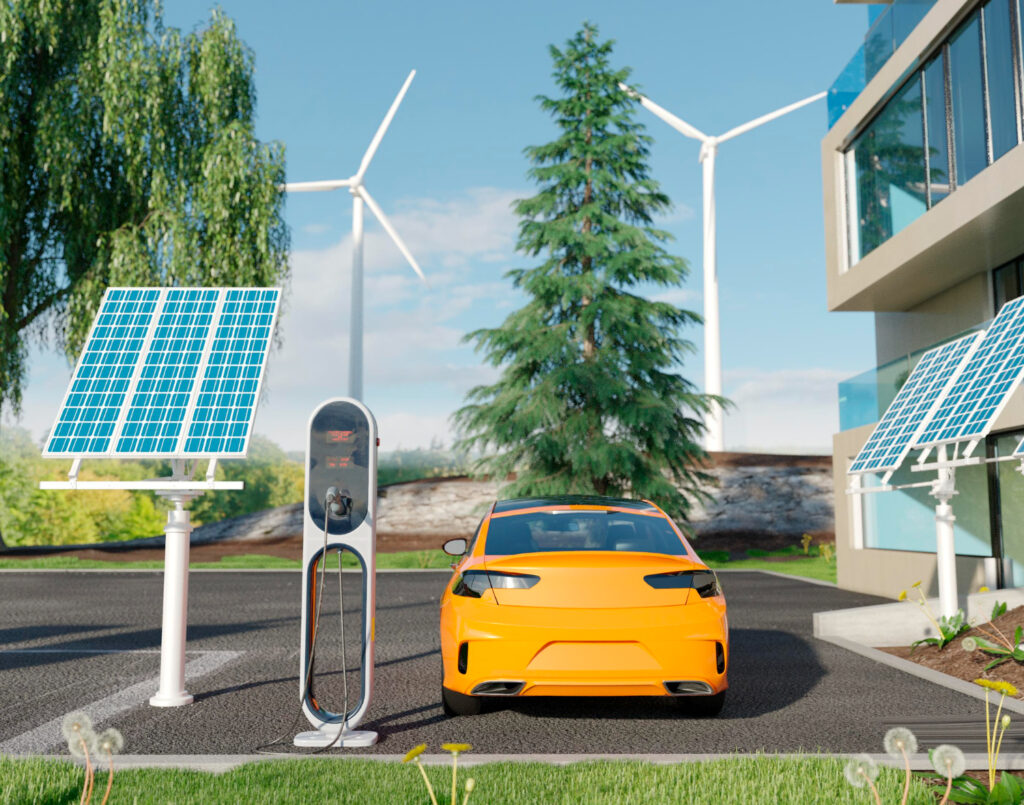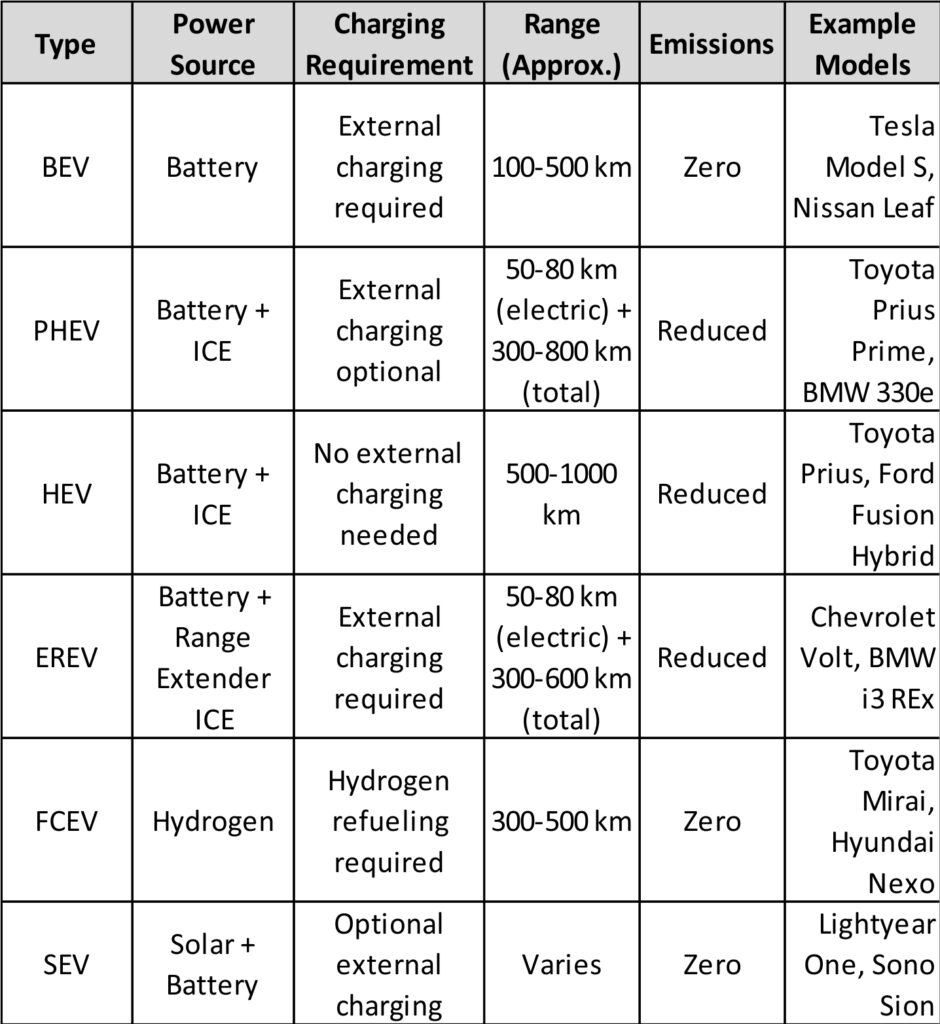Electric vehicles (EVs) present a fantastic alternative to petrol cars, offering a way to significantly reduce your carbon footprint while providing user-friendly operation. In a bold move towards sustainability, India has set ambitious targets: by 2030, it aims for 30% of private cars, 70% of commercial vehicles, and 80% of two- and three-wheelers to be EVs. With various government initiatives accelerating the adoption of EVs, this guide is here to answer all your EV-related questions.
Table of Contents
Toggle
What is an EV or Electric Vehicle ?
An Electric Vehicle (EV) is a type of vehicle that uses electric motors and batteries instead of traditional petrol or diesel engines. EVs are environmentally friendly, producing zero emissions and significantly reducing your carbon footprint. With advancements in technology, EVs offer impressive performance, efficiency, and lower maintenance costs. For those interested in making the switch, check out our list of the “Top 10 EV Cars to Buy in India.” This guide highlights the best options available, showcasing cutting-edge features and reliable performance, making it easier for you to choose the perfect EV for a sustainable future.
How EV works ?
Electric vehicles (EVs) work by using an electric motor powered by rechargeable batteries. The batteries store electrical energy, which is converted into mechanical energy by the motor, propelling the vehicle. Unlike traditional internal combustion engines that rely on burning fuel, EVs use electricity, reducing emissions and increasing efficiency. The batteries can be charged via standard electrical outlets or specialized EV charging stations. Additionally, EVs now feature regenerative braking, which captures and stores energy typically lost during braking. This technology not only extends the vehicle’s range but also enhances overall efficiency, making electric vehicles a cleaner, more sustainable transportation option.
What are the different types of EVs?
Electric vehicles (EVs) come in various types, each with different features and benefits. Here’s an analysis of the different types of EVs:
1. Battery Electric Vehicles (BEVs)
- Description: BEVs, also known as pure electric vehicles, work completely on electric power. They use rechargeable battery packs to store energy.
- Examples: Tesla Model S, Nissan Leaf, Hyundai Kona Electric
- Key Features: Zero emissions, quiet operation, and high efficiency. They require charging setup for recharging the batteries.
2. Plug-in Hybrid Electric Vehicles (PHEVs)
- Description: PHEVs have both an internal combustion engine (ICE) and an electric motor. They can be charged through an external power source and work on electric power for a certain distance before moving to the ICE.
- Examples: Toyota Prius Prime, Mitsubishi Outlander PHEV, BMW 330e
- Key Features: Flexibility of running on both electric and liquid fuel power, less emissions compared to conventional vehicles, and longer driving range.
3. Hybrid Electric Vehicles (HEVs)
- Description: HEVs combine an ICE with an electric motor, but unlike PHEVs, they cannot be charged from an external source. The battery is charged through regenerative braking and the ICE.
- Examples: Toyota Prius, Honda Insight, Ford Fusion Hybrid
- Key Features: Better fuel efficiency, lesser emissions than traditional ICE vehicles, and no need for external charging.
4. Extended Range Electric Vehicles (EREVs)
- Description: EREVs, also known as range-extended electric vehicles, operate mainly as electric vehicles but have a small ICE to generate electricity once the battery is down.
- Examples: Chevrolet Volt, BMW i3 REx
- Key Features: All-electric driving capability with an extended range provided by the ICE, reducing range anxiety.
5. Fuel Cell Electric Vehicles (FCEVs)
- Description: FCEVs use hydrogen gas to power an electric motor. Hydrogen is converted into electricity through a fuel cell stack.
- Examples: Toyota Mirai, Hyundai Nexo, Honda Clarity Fuel Cell
- Key Features: Zero tailpipe emissions (only water vapour), long driving range, and quick refuelling times similar to conventional vehicles.
6. Solar Electric Vehicles (SEVs)
- Description: SEVs are equipped with solar panels that convert sunlight into electrical energy to charge the battery. These vehicles may also have an auxiliary charging option.
- Examples: Lightyear One, Sono Sion
- Key Features: Renewable energy source, reduced dependence on external charging, and potential for unlimited range in sunny conditions.
Comparison of EV Types

The variety of electric vehicle types offers options for different needs and choices. Whether prioritizing zero emissions, fuel efficiency, or range, there’s an EV type that fits different lifestyles and driving habits. As technology progresses, the choice and performance of EVs are expected to improve, further speed up their adoption worldwide
EV Charging Levels
EV charging, an important part of electric vehicle ownership, involves recharging the battery of an electric vehicle using an external power source. Understanding the different types of EV charging options can help you make the best of your EV.
Level 1
This is the basic form of EV charging, using a standard home 120-volt outlet. It’s the slowest method, providing approximately 6-8 km of range per hour of charging. Level 1 charging is ideal for overnight charging at home, making it suitable for EV owners with short daily travels or those who drive occasionally.
Level 2
For faster charging, Level 2 chargers use a 240-volt outlet, similar to those used for everyday appliances like dryers. This method delivers about 50-100 km of range per hour, considerably reducing charging time compared to Level 1. Level 2 chargers are commonly installed at homes, workplaces, and public charging stations, offering more convenience and flexibility for EV owners who need a quicker charge.
Level 3
The fastest charging option, DC Fast Chargers use direct current (DC) to charge the battery quickly, providing up to 80% charge in just 20-30 minutes. However, it is quite expensive and is normally found at public charging stations and are ideal for long-distance travel, allowing drivers to recharge quickly and continue their journey with minimal downtime.
Choosing the right charging method depends on your driving habits, access to charging infrastructure, and daily range needs. With the growing availability of public charging stations and developments in charging technology, owning an electric vehicle is becoming more convenient and accessible than ever. Understanding these options confirms you can well manage your EV’s battery, keeping you on the road and reducing your carbon footprint.
Benefits of Electric Vehicles
Environmental Benefits: EVs produce zero tailpipe emissions, reducing air pollution and contributing to a cleaner environment.
Lower Operating Costs: EVs are cheaper to run compared to petrol or diesel vehicles due to lower fuel costs and fewer maintenance requirements.
Government Incentives: Governments offer many incentives such as tax credits, rebates, and grants to encourage EV adoption.
Quieter and Smoother Ride: EVs offer a quieter and smoother driving experience due to fewer moving parts and the absence of an internal combustion engine (ICE).
Energy Efficiency: EVs convert more of the energy from the grid to power at the wheels compared to conventional vehicles.
Challenges of Electric Vehicles
Higher Initial Cost: EVs usually have a higher initial cost compared to traditional vehicles, although this gets balance by lower running costs over time.
Limited Range: Despite advancements, EVs still have a shorter range per charge compared to petrol vehicles, which can be a concern for long-distance travel.
Charging Infrastructure: While improving, the availability of charging stations can be limited, especially in rural or less developed areas.
Longer Refuelling Time: Charging an EV takes longer than refuelling a petrol or diesel car, even with fast chargers.
Battery Degradation: Over time, the battery’s capacity can degrade, reducing the vehicle’s range and performance.
Top 10 Electric Cars to Buy in India
India’s EV market is expanding, with numerous models catering to different needs and budgets. Here are the top 10 EV cars to consider:
1. Tata Nexon EV
- Range: 312 – 465 km per charge
- Battery: 30.2 kWh , 40.5 kWh
- Highlights: Affordable, robust build, advanced safety features.
- Starting Price: 14.49 Lakh*
2. MG ZS EV
- Range: 419 km per charge
- Battery: 50.3 kWh
- Highlights: Spacious, feature-rich, fast charging.
- Starting Price: 18.98 Lakh*
3. Hyundai Kona Electric
- Range: 452 km per charge
- Battery: 39.2 kWh
- Highlights: Long range, premium features, smooth performance
- Starting Price: 23.84 Lakh*
4. Mahindra eVerito
- Range: 181 km per charge
- Battery: 21.2 kWh
- Highlights: Budget-friendly, comfortable, reliable for city travel
- Starting Price: 12.68 Lakh*
5. Tata Tigor EV
- Range: 315 km per charge
- Battery: 26 kWh
- Highlights: Compact design, affordable, good for urban use
- Starting Price: 12.49 Lakh*
6. Audi e-tron
- Range: 359 km per charge
- Battery: 95 kWh
- Highlights: Luxurious, high performance, cutting-edge technology.
- Starting Price: 1.02 Crore*
7. Jaguar I-PACE
- Range: 470 km per charge
- Battery: 90 kWh
- Highlights: Stylish, powerful, advanced features.
- Starting Price: 1.26 Crore*
8. Mercedes-Benz EQC
- Range: 455 km per charge
- Battery: 80 kWh
- Highlights: Premium, comfortable, high-tech.
- Starting Price: 1.26 Crore*
9. Nissan Leaf
- Range: 311 km per charge
- Battery: 40 kWh
- Highlights: Popular globally, reliable, eco-friendly
- Starting Price: 30 Lakh*
10. Porsche Taycan
- Range: 484 km per charge
- Battery: 93.4 kWh
- Highlights: High performance, luxury, state-of-the-art technology.
- Starting Price: 1.61 Crore*
Choosing the Right EV for You
When selecting an EV, consider the following factors:
- Range: Check how far you normally drive and choose an EV with a suitable range.
- Budget: Consider the total cost of ownership, including possible savings on fuel and maintenance.
- Charging Infrastructure: Make sure there are sufficient charging facilities in your area or along your travel routes.
- Features: Look for features that meet your needs, such as safety, comfort, and connectivity.
- Incentives: Check for any government incentives or subsidies that can reduce the overall cost of the EV.
Government Initiatives in India
India aims to achieve 30% EV penetration by 2030. The government offers different types of financial incentives to make electric vehicles more affordable for you. The key mechanisms for getting incentives are:
- Purchase Incentives: Direct discount provided to the user on the cost of the electric vehicle
- Coupons: Financial incentive where the amount is reimbursed later
- Interest Subventions: Discount offered on the interest rate while availing loan
- Road tax exemption: Road tax at the time of purchase is waived off
- Registration fee exemption: One-time registration fee applicable on new vehicle purchase is waived off
- Income tax benefit: Provided as a deduction on the tax amount payable by an individual to the government
- Scrapping incentives: Provided upon de-registering old Petrol and Diesel Vehicles
- Others: Incentives such as interest-free loans, top-up subsidies, special incentives on electric three-wheelers, etc. can also be availed
The Future of EVs in India
The future of EVs in India looks promising with increasing investment in EV infrastructure, increasing consumer awareness, and developments in battery technology. As more manufacturers enter the market and government support continues, EVs are set to become a common picture on Indian roads.
Conclusion
Electric vehicles are not just a trend but a important shift towards sustainable transportation. With a variety of models available, from budget-friendly options to luxury vehicles, there’s an EV for everyone. The “Top 10 EV Cars to Buy in India” list showcases some of the best options currently available, catering to diverse needs and choices. As India progresses towards a greener future, now is the perfect time to consider making the switch to an electric vehicle.
Investing in an EV not only benefits the environment but also offers long-term financial savings and a greater driving experience. With continuous developments and supportive government policies, the adoption of EVs is set to speed up, making them an integral part of India’s transportation landscape. Explore the top EV options and find the perfect match for your lifestyle and needs.
